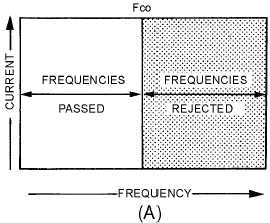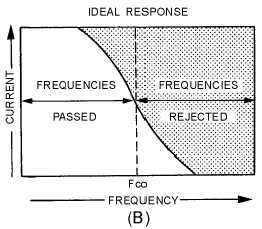1-34
DISCRIMINATION. The ability of the filter circuit to distinguish between high and low
frequencies and to eliminate or reject the unwanted frequencies.
ATTENUATION. The ability of the filter circuit to reduce the amplitude of the unwanted
frequencies below the level of the desired output frequency.
FREQUENCY CUTOFF (fco). The frequency at which the filter circuit changes from the point of
rejecting the unwanted frequencies to the point of passing the desired frequency; OR the point at
which the filter circuit changes from the point of passing the desired frequency to the point of
rejecting the undesired frequencies.
LOW-PASS FILTER
A low-pass filter passes all currents having a frequency below a specified frequency, while opposing
all currents having a frequency above this specified frequency. This action is illustrated in its ideal form
in view (A) of figure 1-15. At frequency cutoff, known as fc the current decreases from maximum to zero.
At all frequencies above fc the filter presents infinite opposition and there is no current. However, this
sharp division between no opposition and full opposition is impossible to attain. A more practical graph
of the current is shown in view (B), where the filter gradually builds up opposition as the cutoff frequency
(f) is approached. Notice that the filter cannot completely block current above the cutoff frequency.
Figure 1-15A.—Low-pass filter.
Figure 1-15B.—Low-pass filter.



